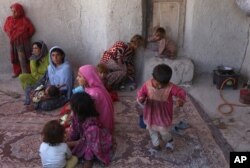The Afghan government has been unable to help some of its most vulnerable citizens, those displaced internally by violence, due to resistance from provincial governments, lack of capacity in key ministries, and corruption, according to the Special Inspector General for Afghanistan Reconstruction.
In an audit letter sent to the U.S. State Department and The United States Agency for International Development (USAID) this week, SIGAR also pointed out the lack of coordination in non-governmental organizations trying to help internally displaced persons (IDPs).
One-point-two million Afghans are internally displaced due to conflict according to an Amnesty International report released in May.
That number has doubled in the last three years, up from 500,000 in 2013, pointing to a sharp increase in people leaving their homes due to violence.
“Even after fleeing their homes to seek safety, increasing numbers of Afghans are languishing in appalling conditions in their own country, and fighting for their survival with no end in sight,” Champa Patel, South Asia director at Amnesty International said.
Afghanistan developed a National Policy on Internally Displaced Persons in 2013, which was supposed to address both the urgent and long term needs of IDPs and their host communities. The situation for the IDPs, however, has “dramatically worsened” since then, according to Amnesty.
Donor fatigue
With the international community also gradually losing interest in Afghanistan, and other crises around the world catching the attention of donors, aid to the country has dropped significantly. IDPs today lack basic essentials, including food and shelter, human rights groups say.
On top of that, provincial governments that were required to help IDPs in their areas either ignored them or made the situation worse, according to SIGAR.
“[A]ccording to State, some provincial governments have not accepted that IDPs have a right to stay in their provinces and were more inclined to regard the IDPs as economic migrants who do not have the same rights, such as the right to food, water, adequate shelter, and health care, as other Afghans,” SIGAR's letter said, adding that in some cases these governments demolished IDP settlements claiming they were supposed to be temporary.
Management failures
The letter also pointed out that the Ministry of Refugees and Repatriation, MORR, which was supposed to distribute pieces of land to IDPs have so far only allocated a little over 50,000 plots, in response to half-a-million applications.
“MORR did not have the budget and lacked proper planning and procedures” to manage a medium- to long-term response to IDPs, according to SIGAR.
However, Sayed Huseen Alimi Balkhi, the Afghan minister of refugees and returnees, said his government was working hard to help the IDPs, despite difficult conditions.
“Based on the National Policy for the Resettlement of IDPs, they should be resettled, but in the past two years intensification of war has prevented the Afghan government from taking effective steps for resettlement of IDPs,” he said.
He added, the Afghan government had worked hard for the rehabilitation of IDPs in Herat, Nangarhar, and Kabul provinces and work continued on shelter, and other infrastructure.










